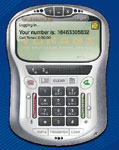...line is sweet. "You spend $3,000...but you dont spend $30,000," he says.
In Portland, Maine, Alan Buck, IT manager at SMRT, an architectural and engineering firm with offices in four northeastern states, already has a couple of years experience with VoIP, and he loves it. "Its so easy," he says. "Its very configurable."
With his old system, every time Buck moved, added or changed a phone he had to call in an outside technician at $150 an hour. Now, he does it himself through a simple software interface. "Thats the beauty of it. In two years, I have not had to call the vendor," Buck says.
Back-End Engineering
 | |
| Engineered. SMRTs Buck says good system design is key. (Photo courtesy of SMRT, Inc.) |
But for all of its manageability, SMRTs system, designed by ShorTel Communications, Sunnyvale, Calif., is carefully engineered to assign bandwidth priority to voice communications, so phone calls will not be interrupted when transmissions of huge CAD files flood the line. It also has several layers of redundancy, including limited connections to conventional phone lines to ensure voice communications in the event of power outages or data system failures.
"Its really great technology," Buck says. "But there is one major drawback: "People must do it the right way. If a company is going to put a voice-over-IP solution in, they would be well served to hire a network engineer to design it for them." Buck is a network engineer but he hired a specialist for his firms system after initially delving into the technology.
"You can really go cheap, but its crazy. Your voice network is the life and blood of your business, and making a change is scary," Buck says. "The unknown is a scary thing when you are an IT manager. You can lose your head over it."
In order to ensure reliability, "You have to have the equipment that will do the quality of service you need, or it will bite you," says Buck. "And you cant cut corners on your Internet T1 [lines]. There are a gazillion vendors out there that sell Internet access, but you have got to go with a tier-1 provider." He warns that cut-price vendors tend to oversubscribe capacity, which is not a big problem for data. But it can kill voice communications no matter how good your office equipment may be.
Ordinary data can tolerate breaks in flow and repair itself by simply retransmitting or gathering in late-arriving packets of information. Voice calls quickly break up or are dropped entirely by transmission lapses. "With voice, there cant be any delivery-time issues," Buck warns.
 
| |||||
| Engineered. SMRTs Buck says good system design is key. (Photo courtesy of SMRT, Inc.) |
One of the kinder and gentler aspects of transitioning from a legacy phone system to an IP-based system like SMRTs is that it can be done in a hybrid fashion that pairs the new system with the old one through the transition. SMRT, for instance, uses the same desk phone sets it always has. They just interface at a switch in the server room for Internet transmission.
Another ShoreTel customer, BKF Engineers, Redwood City, Calif., also hung on to most of its old desk phones when it went to VoIP, saving more than $400 per line and reassuring change-wary staffers in the process. "That versatility was real handy for us, getting started with 250-plus units," says Derrick Crandell, chief technology officer. "The $80 caller ID phone still works beautifully. And I tell our people, the phone is a phone is a phone. Pick it up and just use it. But if you want to take advantage of some of the features, start typing the first few numbers in the window on your computer screen. The phone rings and you pick it up and its dialing."
But BKFs biggest gains have been reduced costs and ease of system management. "Its been an absolute dream," Crandell says. "With the old system when we set up a remote officeeven putting in the same equipment as we had in the main officeit was a nightmare as far as the wiring and the equipment we had to keep adding. And we didnt have least-cost routing, either. Now I just put in data jacks everywhere. There are no phone jacks. And from homefrom anywhereI can make changes, moves, set up call-forwarding, or go to a menu and say, I assign my extension here," he says.
BKFs telecommunications costs have dropped from $100,000 a year for hardware and $15,000 to $20,000 a month for toll calls to a system that cost $180,000 for the initial installation two years ago, $18,000 a year to maintain, and $6,500 in tolls for approximately 45,000 calls per month. "Voice over IP is here and its here to stay," Crandell says.
"If you do it right, VoIP is a wonderful solution" adds Buck. "And your cost savings are tremendous, particularly over time."
| Wireless Networks Are Driving New High-Tech Office Concept
Chicago developer Mark Schlenker steps into the CADMobile. John Jurewicz, a local architect, shows him a set of drawings. They make a few changes, and Jurewicz taps off a few mouse clicks on his computer. Schlenker, approving the revisions, hands over a check to get started on a building renovation project. Jurewicz, 42, a habitual multitasker, owns a firm called AArchitects, Wonder Lake, Ill., and has taught e-construction classes at Northwestern University for five years. He first introduced the CADmobile concept in class discussions and is now marketing three models costing $40,000 to $150,000. More details are found online at www.cadmobile.com. In a prior life, Jurewiczs personal CADMobile was an ambulance. He picked it up at an auction last year for $8,000 and turned it into a $40,000, traveling workstation. Secure extranets, or online data vaults, coupled with expanding wireless networks, are inspiring him and other entrepreneurs to build mobile offices (ENR 2/14 p. 21). "This is all about speed," Jurewicz says. Jurewicz can pull up plans stored in an online archive, send e-mail and teleconference via Internet connectionsall from the vehicle. "A lot of clients want changes. We can do that right in front of the jobsite," he says. Jurewicz recently parked the truck in downtown Chicago and made changes to a permit application on the fly. "It was pretty cool," says Bradley Roback, a local permit officer. The heart of the system is a custom data router that can run three wireless connections simultaneously. One runs on a protocol called Evolution-Data Optimized (EV-DO), which hits the Internet through cellular signals and moves at a typical speed of 400 Kbpsabout the same as a cable modem. The router also reads various Wi-Fi "hotspots," part of a faster network that works within 300 ft of about 15,000 libraries, restaurants, hotels and truck stops in the U.S. It also takes satellite feeds from a 200-lb dish on the trucks roof. The router beats some common wireless Internet problems. These include often spotty network availability; connections for downloads that are fast, but typically drag on the upload; and Web tools, such as voice-over-Internet protocol, that conflict with some wireless providers. Jurewicz has two patents pending on the router. Theres plenty of power under the vehicles hood, too. The chassis is a 1991 Ford F-350, with a 7.3-L diesel engine. For a 5% boost in fuel economy and an extra push uphill, Jurewicz installed a continuous propane injector. A pull-start gasoline generator has an output of 2,000 Wattsenough juice to run a computer, plotter and printer at once. Four lead-acid batteries power office accessories for up to one hour. In the back, there is a flip-down table for plans and whiteboards that allow the cabin to be used as a conference room. Jurewiczs workstation has two Pentium-4 processors; a 17-in., LCD monitor; an inkjet plotter and a printer/fax/scanner. The truck seats nine and even has a microwave for snacks. The first prototype was developed two years ago. "We started with a laptop and a plotter in the back of a Jeep," says Jurewicz. But the rough ride took a toll on the office gear. The current truck has an air-ride suspension. A gel-pack cushions the computers hard drive. One large sale is pending.
| ||||||||




Post a comment to this article
Report Abusive Comment